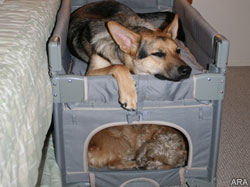
Is there a more perfect union of loyalty, love and friendship than the relationship between a child and pet? Probably not, as virtually any parent who has witnessed the positive effect pet ownership has had on a child will tell you.
Growing up with a pet benefits children in many ways, including improving self-esteem and self-confidence, helping in developing trusting relationships with other people, and helping develop nonverbal communication skills, compassion and empathy, according to the American Academy of Child and Adolescent Psychology. In fact, pets are such an integral part of life for American children that more kids in this country live with pets than live with both parents.
To help children get the most out of their relationship with their pets – and to help them grow into fulfilled pet-owning adults – it’s important to teach them how to be responsible pet owners. Consider this helpful advice when educating your child about how to care for a pet:
* If you’re bringing a new baby into a household where a pet already lives, consult with your vet on how to make the home environment as safe and happy – for both pet and child – as possible. If you are thinking about getting a pet for your family, keep in mind age appropriateness. Infants and very small children will not be able to participate in a pet’s care. Some young children may be able to care for a small pet, like a hamster or gerbil, with adult supervision. The care of larger pets, including cats and dogs, should be limited to children older than 7 – and only with adult supervision. No child should ever be made entirely responsible for a pet’s care.
* Encourage safe, healthful sleeping habits. Co-sleeping with a pet offers many benefits for a child, including stronger bonding and a sense of security. But pets should not sleep in bed with children – for both the health of the child and pet. Even the hardiest child may wake up with red, itchy eyes after spending eight hours snuggled up to pet hair and dander. And sharing the same bed puts small pets at risk for being smothered or harmed when a child rolls over – or puts small children at similar risk if the pet is larger than they are.
A better solution is a Pet Bunk Bed by Arm’s Reach (www.armsreach.com), the co-sleeping experts who have helped thousands of mothers safely co-sleep with their newborns. The plush bunk bed fits snugly against a human bed (26 to 30 inches in height), giving pets their own safe, secure sleeping spot within easy reach of their human companions. The pet bunk beds can accommodate pets weighing up to 100 pounds, and upper and lower levels allow two pets to co-sleep with their humans at the same time. In addition to providing a safe sleeping environment for children, the pet bunk bed also is great for older pets or puppies or kittens that may need more attention throughout the night.
* Ensure children understand that taking your pet to the vet for regular checkups is an important part of pet ownership. Get kids involved in the pet’s health by asking them to help track appointment dates on a calendar, doing online research to see what immunizations their pet may be due for at each appointment, and taking them with you – when possible and practical – for routine pet checkups at the vet. A word of caution, though – never allow children to hold a pet during an exam or when a shot is being administered. Even the most loving pet may feel stressed and afraid – and could growl, snap or even bite – in such situations. Either hold the pet yourself, or seek the aid of a veterinary technician, who’s experienced in holding and soothing frightened animals.
Courtesy of ARAcontent





